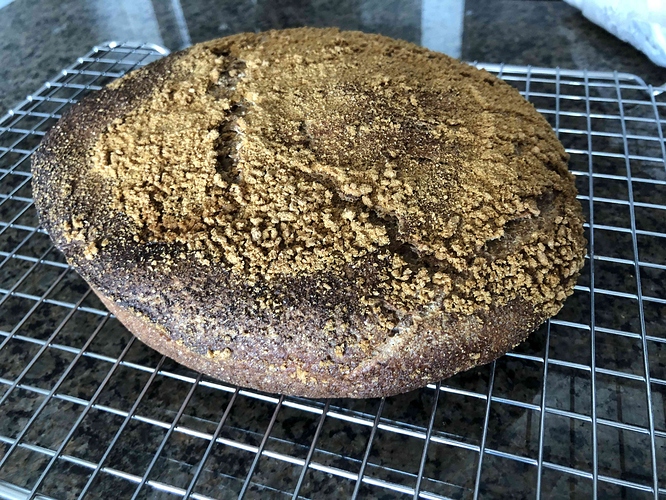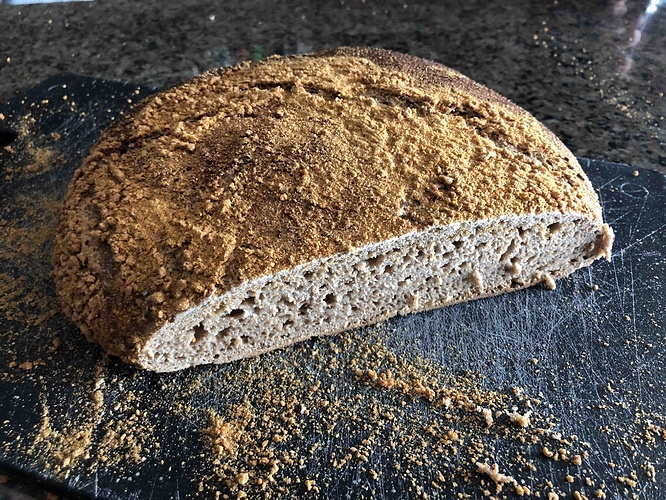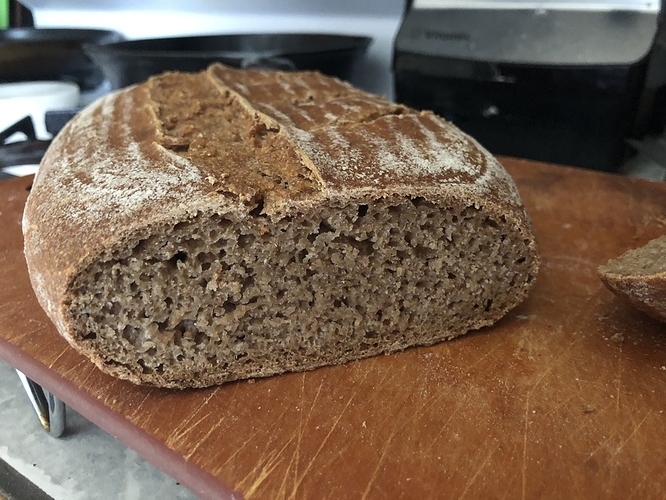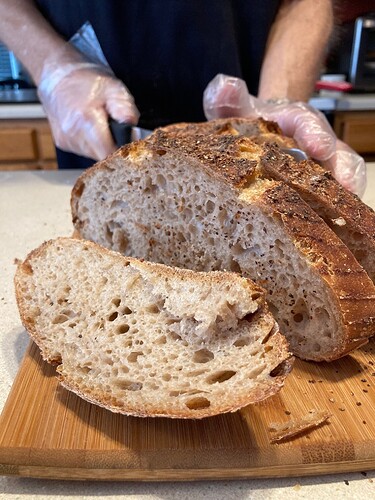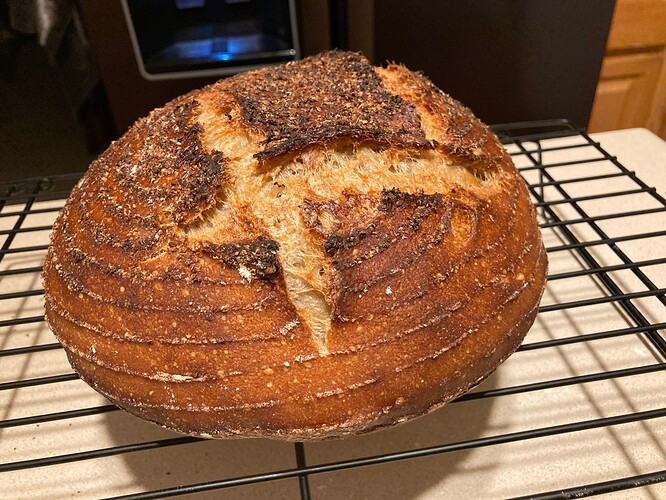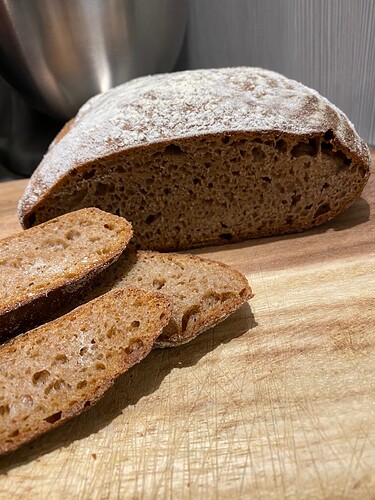Beautiful!
I agree with Leah! And i imagine the flavor and aroma are as amazing as it looks 
Hi Melissa,
Thanks for sharing this recipe. It turned out to be a bit of a disaster for me, unfortunately. There are so many beautiful pics of other’s success, I had high hopes for this - I’m not exactly sure where I went wrong. I’ve had a lot of success with my starter with sourdough recipes from King Arthur’s website, but in this case I think I may have let my starter ripen too long (about 18 hours at room temperature). Also, I don’t have a baking vessel so I used a pre-heated cast iron pan uncovered at 475F for 35min. I think it was probably too hot, I ended up with a very tough crust with a moist interior. Also, I think I used too much bran in the proofing bowl - I substituted for ground fibre cereal. It’s edible and tastes good, but clearly the texture is all wrong. I’d like to try this recipe again, do you have any advice on what I should do differently for someone without a baking vessel? Thank you 
-Matt
Matt,
I’m glad your bread is still tasty. Toasting each slice can solve gumminess, also cutting off the tough crust etc. Hopefully the next bread works out better.
Unless you fed your starter a LOT of flour and water (maybe 1:3:3 starter, flour, water) and kept it in a cold room, 18 hours probably did exhaust the food supply.
Do you have a baking stone or steel? That info will help me give you a recommendation on how to bake the next loaf.
Hi Melissa,
Thanks for your reply. Yes, I must have under-fed the starter for an 18 hour ripen at room temperature. I’ll limit that to 12 hours next time (I used 1:1:1 ratio). And yes, I have a baking stone and a steel baking sheet with a silicon baking mat. Any suggestions you have will be a tremendous help.
Thanks again! 
-M
Beware the idea that you can pre-determine the correct length of time to proof sourdough bread dough. It just doesn’t work like that. Because sourdough is a microbial culture of living things that are affected in all kinds of ways by the environment, you have to pay attention to the dough and learn to know when it’s ready by how it looks, smells, feels.
Here’s more words about all that:
And more:
I agree with what Paul wrote, and also should have added that your possibly exhausted starter, if given enough time to work on your dough, would be able to get active and do it’s job just fine!
Here is a recipe that goes over a strategy for baking bread on a pizza stone. I get good results for baguettes and ciabatta with the strategy. Boules and batards are not bad, though truthfully a covered baking vessel always works better for me. I will throw out there that when i started baking, i was right away into doing two loaves at once and my second baker was the glazed ceramic interior of a slow cooker with aluminum foil as the “lid” and it worked great.
Thank you so much, Melissa and Paul!! I actually have a slow cooker with a glazed ceramic interior, so I’ll try that as my baking vessel next time - what a great idea! And yes, I’ll be much more careful with my starter going forward - I’m still getting to know its life cycle. I can’t thank you enough for the great advice, I’m looking forward to trying this recipe again. I’ll let you know how it goes!
Warm regards to you both,
-Matt
You’re welcome!
(Make sure the foil is tight.)
Oh and another option is preheating your baking stone/steel and a large roasting pan lid if you have one, and using those two pieces. You’d get more thermal mass from the roasting pan lid over the loaf than foil. I don’t happen to have a lid that large though so never tried it myself.
This is the first time I’ve made a Red Fife-specific recipe and the flavor is outstanding! As for texture and rise, I’ve had mixed results.
The 40% version was perfect. Perhaps the best bread I’ve ever baked.
The 100% version was a fail. Great flavor, but absolutely no rise at all. I have no idea what happened. The fridge proof was on the long side, 12 hours or so (which I also did with the 40%, and it worked well). When I took it out, I knew it was going to do poorly–it went into the fridge wet, and came out having dried out terribly at the bottom of the basket. The dough was fragile, not stretchy. Perhaps it needed help from a little sprinkle of commercial yeast? Less proofing? I don’t have much experience with 100% whole wheat.
It is such a great flavor!
I think your 100% whole grain bread looks pretty good, though, especially on the inside. My hunch is that the oven spring would have been bigger if the fermentation was a little shorter. Whole grain flour ferments a bit faster and the weaker gluten structure doesn’t hold up as well to longer ferments. If I had to err on one side, though, and I often do err  I would go for too long (for the nice flavor and honeycomb crumb).
I would go for too long (for the nice flavor and honeycomb crumb).
I recently bought your bolted red fife flour, and made the 40% red fife sourdough bread. The bread is still warm, but I couldn’t wait to try a slice. The crust is awesome. It’s so crunchy. I love it!
I made the 40% Red Fife last week and it came out great. Yesterday I made 100% Red Fife. The initial flour water mix was very stiff, and I wondered whether it might need extra water since we are in Denver (it’s very dry and we are at altitude). I added the starter and salt and left it overnight about 10 hours; I put it in the oven with the light on at 80 degrees, since our house is about 64 at night. When I went to turn it out it was incredibly liquidy. I added flour and proceeded so I will see how it turns out, but I am wondering if this is a known issue with leaving it too long. Any suggestions/comments would be welcome.
100% red fife will behave totally different to 40% red fife and 60% strong bread flour. From hydration to handling and fermentation. On top of that you fermented at 80°F overnight for an extended period of time. If you’re going for an all night ferment better in a cool spot and wait longer if necessary then to ferment in a very warm place and overdo it. Plus it’s 100% wholegrain which would have sped things up!
Thanks. I will try that next time. Still tastes great, just not as airy as it should be. I was just surprised that it was so liquid. I expected that if it had fermented too long it would be less bubbly but similar consistency.
Made the 40 percent red fife recipe. I’m new to baking and this is the first recipe that turned out wonderfully. The crumb turned out like the pictures shown, the aroma and crust is superb. Watching all the the videos repeatedly helped in getting a feel for it
process and what the dough should look like in each step before doing it myself. By the time I was ready to mix it, it was almost as if i did it before. Thanks for the recipe!Wonderful bake, I love red fife it is my go to whole wheat when baking bread.
Benny
This 100% red fife loaf came out of my oven this morning. I reduced the ingredient volume by 20% as I didn’t want a large loaf. I overdid it on the bulk fermentation and left the formed loaf too long in the fridge! The result was kind of pancakey with a mediocre crumb that was just this side of gummy! However, it is wonderfully delicious, so it’s a win!  Mistakes seem to have become learning experiences for me!
Mistakes seem to have become learning experiences for me!
Still a lovely bake Martha. That’s the thing about baking bread, even if our bakes aren’t perfect they still usually taste great as I’m sure yours did.
Benny
I love this bread and flour. I’ve been baking it for some time, settling on an 80% or 85% whole grain version that seems to rise really well. Recently, I’ve gotten in the habit of adding walnuts to various recipes, and I’m wondering if folks have thoughts about when in the process it is generally best to do so. I’ve seen in some recipes that nuts get added with the first or second fold; I’ve seen others where they are added much later, when preshaping. I imagine that, whenever you do it, there is some disruption to the gluten development. I’m happy to experiment, but if there is some theory one way or the other, I’d love to hear. Cheers.
